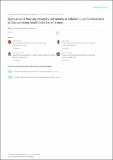| dc.description.abstract | The heterogeneity of smallholder dairy production systems complicates service provision, information sharing, and dissemination
of new technologies, especially those needed to maximize productivity and profitability. In order to obtain homogenous groups
within which interventions can bemade, it is necessary to define clusters of farmers who undertake similar management activities.
This paper explores robustness of production cluster definition using various unsupervised learning algorithms to assess the best
approach to define clusters. Data were collected from 8179 smallholder dairy farms in Ethiopia and Tanzania. From a total of
500 variables, selection of the 35 variables used in defining production clusters and household membership to these clusters was
determined by Principal Component Analysis and domain expert knowledge. Three clustering algorithms, K-means, fuzzy, and
Self-Organizing Maps (SOM), were compared in terms of their grouping consistency and prediction accuracy. The model with
the least household reallocation between clusters for training and testing data was deemed the most robust. Prediction accuracy
was obtained by fitting a model with fixed effects model including production clusters on milk yield, sales, and choice of breeding
method. Results indicated that, for the Ethiopian dataset, clusters derived fromthe fuzzy algorithm had the highest predictive power
(77% for milk yield and 48% for milk sales), while for the Tanzania data, clusters derived from Self-Organizing Maps were the
best performing.The average cluster membership reallocation was 15%, 12%, and 34% for K-means, SOM, and fuzzy, respectively,
for households in Ethiopia. Based on the divergent performance of the various algorithms evaluated, it is evident that, despite
similar information being available for the study populations, the uniqueness of the data fromeach country provided an over-riding
influence on cluster robustness and prediction accuracy.The results obtained in this study demonstrate the difficulty of generalizing
model application and use across countries and production systems, despite seemingly similar information being collected. | en_US |

